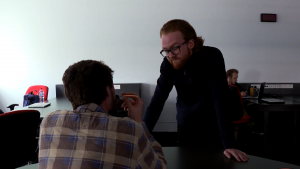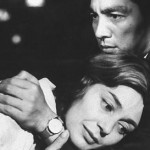Last week in class we experimented with using a dolly camera setup. I am really happy I got the chance to do this because it was something I had never done before and I had written about wanting to try it out in my initial blog post for this studio… so now I can tick that one off my list!
Above is a video of all the ‘good’ takes we shot; and by ‘we’ I mean Gabe, Tim, Polly, Bridget and myself. We each had a turn of acting, directing and DoPing a shot, investigating various ways we could frame, focus and move the camera. Please ignore the audio for these videos; we didn’t use an external microphone because the dolly made it difficult to have cords running off the camera, but we discovered pretty quickly that it would be necessary to have a uni-directional microphone because the dolly track makes a lot of noise.
Initially we experimented with having the actor in the scene move before the camera (and having the camera follow) to see if this changed the effect of the shot in comparison to when the camera moved first and almost ‘predicted’ where the actor would move. In all honesty, I don’t mind the sequence either way (whether the camera is leading or following). Obviously the aim of the game is to have both the camera and actor’s movements synchronised, but often this is almost impossible; thus the director needs to make a motivated decision as to whether the camera should lead or follow the actor’s actions. If I had to decide between one or the other, I think it would be best to have the camera lead, because if the camera is lagging it can just look like the DoP wasn’t keeping up with the action.
I directed the last shot in this video (the dolly forward), with Bridget as my DoP and Polly as my grip/focus puller. Aside from the framing, I quite like the shot because the dolly forward as Tim walks towards his ‘student’ makes the scene feel rather dramatic and builds Tim up as an overbearing, ‘scary’ character (which is also helped by his dominance in the frame, as he appears much taller than Gabe, the student). The way Tim leans over Gabe and whacks the exercise book down on the table also adds to his ‘interrogating’ persona. Nevertheless, I struggled to get the framing right for this shot. In some respects I like ‘framing option 1’, because Tim remains at the centre of the frame the entire time, which encourages this audience to focus on his actions. However, the end frame of the dolly feels imbalanced because Gabe takes up the left side of frame and then there is just a lot of negative space on the right of frame.

So I tried to fix it in post by cropping the shot so I could make the end frame into a normal, symmetrical, two shot.

However, this didn’t work either because it made the beginning look odd: Tim walks slightly on the right of frame and then there is all this negative space on the left side of frame.

If I was to try to do this shot again, I would experiment with setting the dolly up on a slight diagonal so that Tim would be centred in the frame at the beginning of the shot and then he would end up being on the right side of frame by the time he got to Gabe. In addition, I could play around with the positioning of Tim in the space.
I think this framing problem could have also been helped if I had have been able to see the camera display screen on an external monitor. As a director I didn’t want to interfere with Bridget or Polly too much, but this meant that I couldn’t see what was being shot the whole time. I could make sure that the start and end frame were where I wanted them to be, but I couldn’t really get an idea of how the camera would move through space until we played it back after the shot was taken. With this in mind I asked if we could use the monitors in our next class. We ended up doing a multi-camera exercise with the monitors, which was beneficial because the whole class was able to view what was being shot through three different cameras at the same time. We were also able to match up our ‘shot-reverse-shots’ in real time, rather than waiting until post, where they sometimes don’t work out (often because eye-lines don’t match up) and then it is all too late to fix.
Most of the time for the stuff I am shooting I would not need a monitor, because I don’t mind directing as well as operating the camera. However, I think if you are having a large crew (with a grip, a focus puller and DoP) it would definitely be advantageous to use a monitor, so that the director can see exactly what is going on in the frame, without getting in the way of everyone else.
To colour grade these sequences I applied an adjustment layer on Adobe Premiere across all of the clips. I think this method may have made a few of these shots too dark, as I was trying to compensate for the over-exposed shots. If I was concentrating on colour correction I would go through each shot separately to attempt to fix some of the white balance and exposure problems. I think I might focus on this more in my next edit and try to use Adobe Speedgrade, which is a specialised colour grading program that I have not trialed before.
Overall, I loved playing around with the dolly and I am considering including a tracking shot in whatever I end up shooting in the later part of this semester. I think the movement of the camera is subtle (as long as the movement is motivated) and smooth when the camera is placed on a track. I generally prefer this type of camera movement over hand-held or steadicam movement, unless there is a need for a ‘shaky’ or more realistic style of camerawork stemming from a documentary aesthetic. Using a dolly was also an easier way to employ camera movement in a technically professional manner, because we could mark our start and end point on the track and then mark our camera focus rim in accordance with the camera’s distance away from the focal point. The precision and fluidity that the dolly offers gives this method one up over hand holding the camera, which can make it far harder to keep the subject in focus.















